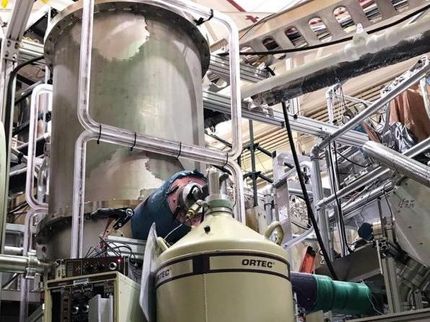No evidence of the double nature of neutrinos
The Majorana nature of neutrinos and the neutrinoless double-beta decay
After two years of searching for a special radioactive decay that would provide an indication of new physics beyond the standard model, an experiment deep under ground near Carlsbad (New Mexico, USA) has so far found no evidence of its existence. If this decay indeed exists, its half -life must be more than a millionbillion times longer than the age of the universe.
Neutrinos are tiny, neutral elementary particles that, contrary to the standard model of physics, have been proven to have mass. One possible explanation for this mass could be that neutrinos are their own antiparticles, so-called Majorana particles.
Though experimental evidence for this is still lacking, many theoretical extensions of the standard model of physics predict the Majorana nature of neutrinos. If this hypothesis proves to be true, many previously unanswered questions about the origin of our universe and the origin of matter could be answered.
650 meters of shielding
In the EXO-200 experiment (Enriched Xenon Observatory), which is operated in the U.S. state of New Mexico, 650 meters below the earth’s surface, scientists are looking for the evidence. Physicists from the research group of Professor Peter Fierlinger of the Excellence Cluster Universe at the Technische Universitaet Muenchen are major contributors to this experiment. The most sensitive method to experimentally verify the Majorana question is the search for a process called "neutrinoless double-beta decay". This process is a special radioactive decay that may only occur if neutrinos are their own antiparticles.
Unprecedented accuracy
The EXO-200 experiment has searched for these decays over several years. From the fact that not one of these decays has been detected, the scientists can now deduce a lower limit for the halflife of the decay of at least 1025 years – around one million-billion years more than the age of the universe.
"Although this measurement attains unprecedented accuracy, the question about the nature of neutrinos can still not be answered," says Dr. Michael Marino, member of the research group of Professor Peter Fierlinger and responsible for the analysis of the now published data. "That's why this open issue remains one of the most exciting questions in physics."
This result demonstrates the high sensitivity of the detector and also the future potential of this method. Hence the EXO-200 measurements are also the basis for a much larger future experiment that finally could confirm or refute the Majorana nature of neutrinos."
International cooperation
The EXO-200 experiment uses liquid xenon that was enriched to 80.6 percent of xenon-136 in Russian centrifuges. Xenon-136 is an isotope that is allowed by theory to undergo neutrinoless double-beta decay. The experiment's location in the Waste Isolation Pilot Plant (WIPP) 650 meters below ground provides shielding against radioactive decays and cosmic radiation.
Original publication
J. B. Albert, et.al., "The EXO-200 Collaboration: Search for Majorana neutrinos with the first two years of EXO-200 data."; Nature, Adv 2014
Other news from the department science

Get the analytics and lab tech industry in your inbox
By submitting this form you agree that LUMITOS AG will send you the newsletter(s) selected above by email. Your data will not be passed on to third parties. Your data will be stored and processed in accordance with our data protection regulations. LUMITOS may contact you by email for the purpose of advertising or market and opinion surveys. You can revoke your consent at any time without giving reasons to LUMITOS AG, Ernst-Augustin-Str. 2, 12489 Berlin, Germany or by e-mail at revoke@lumitos.com with effect for the future. In addition, each email contains a link to unsubscribe from the corresponding newsletter.


























































